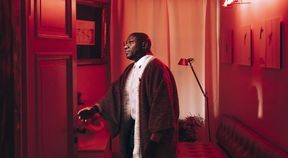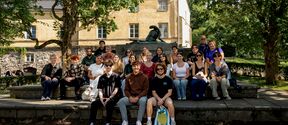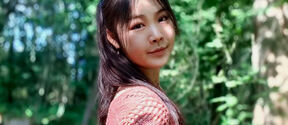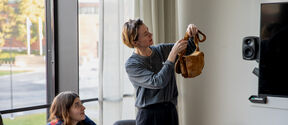Designer Lincoln Kayiwa wants to create heirlooms

A calling was stirring in his soul, but the 8-year old boy sitting on his boarding school bunk bed in Uganda’s capital Kampala didn’t know it at the time. Young Lincoln Kayiwa was fiddling with a string, a bean, a bottle top, and a twig. He wanted to combine them to make something functional.
‘I didn't even know there was a word for what I felt,’ he says.
Today, Kayiwa is a designer whose projects are shaped by his bicultural background. He has now lived in Finland for 19 years—nearly as long as he lived in Uganda—and his work draws on those combined experiences.
‘I’ve been here long enough now to know how Finnish design culture and Finnish society work, but I’m also outside the box looking in,’ Kayiwa says.
That unique perspective is the fruit of a chain of happy coincidences.
What is this country?
Though Kayiwa had artistic leanings as a youth, it wasn’t clear he would become a designer. Many Ugandans of older generations hoped to see their children pursue careers in fields they regarded as prestigious, and his parents were no exception. His father, who was an architect, had hoped that he would become an engineer.
Kayiwa was still a secondary school student with a passion for visual art, especially drawing, when his father passed away. ‘He might have understood my choice, but unfortunately he didn’t get a chance to,’ says Kayiwa.
Fortunately, his mother accepted his claim that he would be better off continuing at a performance arts school rather than the traditional, missionary-built academic school, which focused more on the sciences.
After continuing studying art at Makerere University in Kampala, Kayiwa attended a lecture by visiting professor David Stairs from the Massachusetts Institute of Technology.
‘The majority of the slides were of Finnish designers, and I was astounded by that,’ he says.
Finland was already on the young man’s mind. He knew that the then-ubiquitous Nokia phones were Finnish products, and his father had also been fond of rally driving, a motorsport in which the country is known to excel.
‘I had encountered Finland in so many different circumstances, so all of a sudden I was wondering “What is this country?” It seemed a bit like fate or destiny,’ he says.
Researching the country, he learned about its female president and 188 000 lakes. ‘It felt like a fairy tale, and I just had to experience it for myself.’

Fusion of art and design
This was around the time Kayiwa was supposed to do a work placement or exchange studies. He applied as an exchange student to the University of Art and Design Helsinki (TAIK), one of the institutes that later merged to form Aalto.
Impressed by the experience, he continued at TAIK as a Master of Arts student. Kayiwa took advantage of the unparalleled freedom he had to study different topics. He used the opportunity to experiment with the many tools and techniques available at the school.
‘I studied photography and took courses in the graphics design department and other departments. I had this thirst and hunger to learn because I hadn’t had facilities like that where I had come from, so I wasn’t taking the opportunity for granted,’ he says.
That breadth of experience is reflected in his work today. ‘In a way, that defines my practice. It’s not 100% design—it’s a fusion of art and design,’ he explains.
He says that the freedom to explore during his studies has led him to design not only furniture but also homeware such as candleholders, chopsticks, and glassware. He also works with a range of materials, such as ceramic, wood, glass, and granite.
‘In general, I’ve never been one for definitions or for being boxed in. I want to leave things open to interpretation, appreciation, and critique. That’s also my approach with design. It’s not a concrete process—I just have a sense of it and it’s in flux all the time.’
The country he had been drawn to also lived up to its appeal; he stayed after finishing his studies, opening an eponymous design studio in 2007 and becoming a naturalized citizen.
Driven by a different sense of value
Currently, he’s working with artisans in Kenya to use waste as a raw material, upcycling waste plastic, glass, rubber or metal into furniture or other useful objects.
‘I provide the design concepts, and they iterate on them using the handicrafts and know-how they’ve gathered over years,’ he says.
‘The main objective is to show the artisans that they can use the crafts and techniques that they already know to make something functional instead of just decorative items for tourists.’
The project fits well with Kayiwa’s overall commitment to sustainable design, a theme that’s built into the structure of his business. ‘I want to stop using virgin raw material in my studio. Everything should be made with 90–100% recycled materials.’
He says designers and manufacturers need to adopt an approach that’s driven by a different sense of value. The goal should be to make only what we need, design those things beautifully, and build them to last. Rather than aiming to have a new product ready for each season, designers should work to create heirlooms.
‘I want my designs to make the user happy, but I also want them to be exactly as I intended without any compromises,’ says Kayiwa.
The story behind the dinosaur-inspired clothes rack he designed offers an example of his principles and persistence. When he first conceived the design, 3D printers weren’t big enough to print the elements. They could have been made with plastic extrusion, but the resulting seams would reduce the similarity to dinosaur bones which was the heart of the design. Instead, Kayiwa waited, and eventually 3D printers had beds big enough to produce each hanger in a single print. ‘I’m happy that I didn’t compromise myself as a designer. It’s done exactly the way it was meant to be.’
By using 3D printers instead of making molds for plastic extrusion, Kayiwa fulfill another goal of his designs: avoiding waste and producing just enough to meet demand. Well-designed that are crafted to purpose rather than mass produced offer a way to use fewer resources and live more sustainably, he says.
‘We humans should open our eyes to what we buy and how we consume. We need to curate the things that we live with and surround ourselves with.’
With that ethos in mind, Kayiwa calls the items he designs ‘collectibles’ rather than ‘products’ and prefers to think of ‘users’ rather than ‘consumers’.
Those goals inform everything done at his studio. All of the items are customizable and made just to order. ‘They’re made the way they’re supposed to be made and with the best of materials,’ he says. ‘You know they’re going to be used and eventually passed on.’
Lincoln Kayiwa|
- Graduated with a Master of Arts from the University of Art and Design Helsinki (now Aalto University) in 2007
- Founder and CEO of KAYIWA, a studio selling custom furniture and houseware to clients in the US and around the world
- Received support from the Tekes (now Business Finland) Designium TULI program to commercialise his graduation project
Is also|
- Someone who enjoys solitude as much as company: ‘I enjoy the duality, and Finland offers that. I feel like I was Finnish before I knew I was Finnish.’
- A collector of contemporary Finnish art: ‘I love art, and I’ve been to more art exhibitions than design events. It helps to get inspiration from elsewhere.’
- Pushing for a better world: ‘I want to stop using virgin raw material in my studio. Everything should be made with 90–100% recycled materials.’
This article has been published in the Aalto University Magazine issue 30 (issuu.com), April 2022.
Read more news

“This hands-on approach is the absolute best way to learn” – Loyola University and Aalto University partnered for the sixth time
Isabel Towghi shares her experience from Aalto University Summer School.
From award-winning food packaging to researching biodesign spaces
From an early age, Ena Naito was drawn to both the sciences and design. She found the perfect place to bring those two worlds together.
See Me Make, Make Me See
A Nordic Exploration of Craft, Observation and Language






